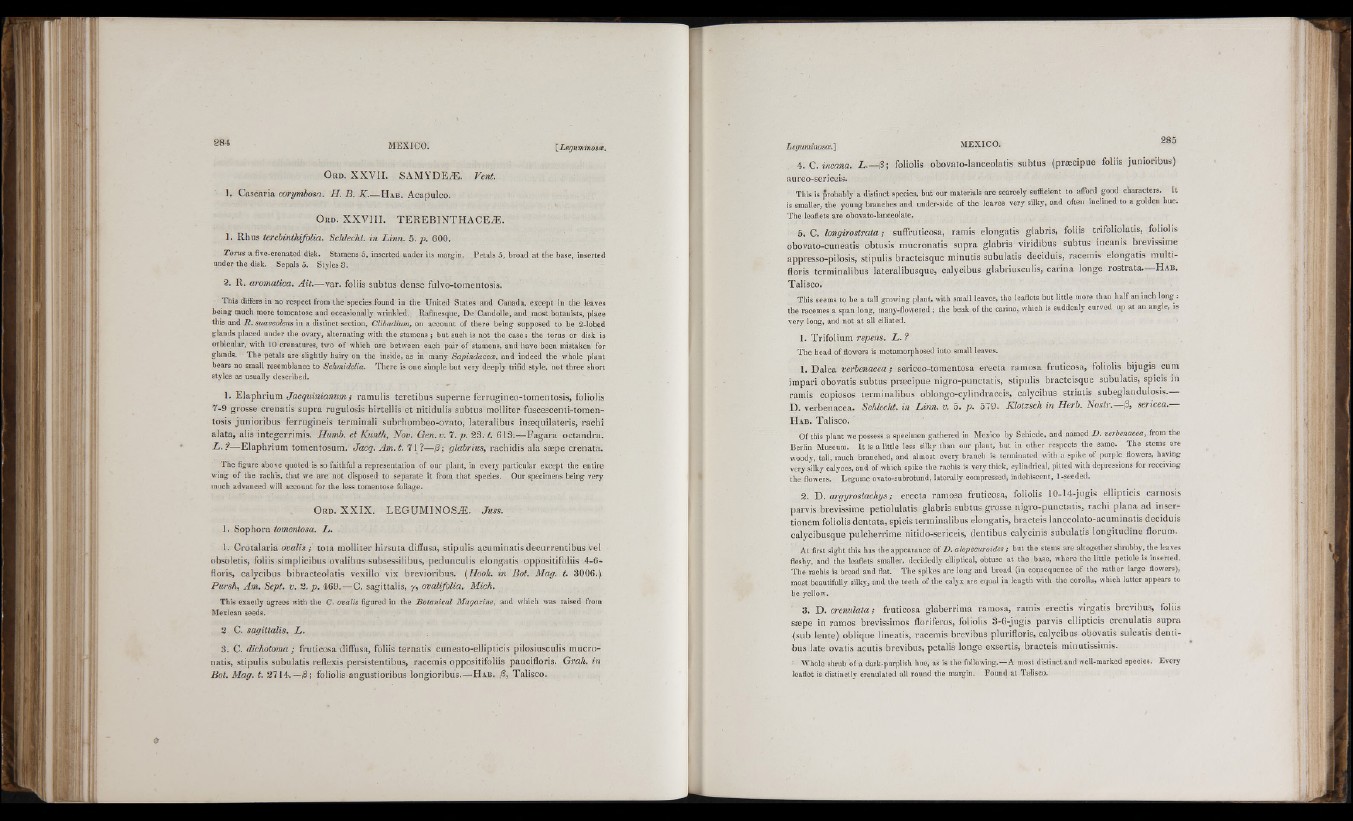
O r d . X XV II. S A M Y D EÆ . Vent.
1. Casearia corymfeosa. H. B . K .— Hab . Acapulco.
O r d . X X V I I I . T E R E B IN T H A C E Æ .
1. Rh u s terebinthifolia. Schlecht. in Lin n . 5. p . 600.
T o n s a five-crenated disk. Stamens 5, inserted under its margin. Petals 5, broad at the base, inserted
under the disk. Sepals 5. Styles 3.
2. R. aromatica. A it.—var. foliis subtus dense fulvo-tomentosis.
This differs in no respeet from the speeies found in the United States and Canada, except in the loaves
being much more tomentose and occasionally wrinkled. Rafinesqiie, De Candolle, and most botanists, place
this and R . suaveolens in a distinct section, Clibadium, on account of there being supposed to be 2-lobed
glands placed under the ovary, alternating with the stamens ; but such is not the case : the torus or disk is
orbicular, with 10 crenatures, tsvo of which are between each pair of stamens, and liave been mistaken for
glands. The petals are slightly hairy on the inside, as in many Sapindaceoe, and indeed the whole plant
bears no small resemblance to Schmidelia. There is one simple but very deeply trifid style, not three short
styles as usually described.
1. El.apbrium Jacquinianum ; ramulis teretibus superne ferriigineo-tomentosis, foliolis
7-9 grosse crenatis su p ra rugulosis hirtellis e t nitidulis subtus molliter fuscescenti-tomentosis
ju n io rib u s ferrugineis terminali subrhombeo-ovato, lateralibus inæquilateris, rachi
alata, alis integerrimis. Humb. et Kunth, Nov. Gen.v. 7. p. 23. t. 613.— F ag a ra octandra.
L . f— E lap h rium tomentosum. Jacq. Am. t. 71 ?— glabrius, rachidis ala sæpe crenata.
The figure above quoted is so faithful a representation of our plant, in every particular except the entire
wing of the rachis, that we are not disposed to separate it from that species. Our specimens being very
much advanced will account for the less tomentose foliage.
O r d . X X IX . L E G U M IN O SÆ . J u s s .
1. Sophora L .
1. Crotala ria ovalis; to ta molliter hirsuta diffusa, stipulis acuminatis d ecurrentibus vel
obsoletis, foliis simplicibus ovalibus subsessilibus, pedunculis elongatis oppositifoliis 4-6-
floris, calycibus bibracteolatis vexillo vix brevioribus. {Hook, in Bot. Mag. t. 3006.)
Pursh, Am. Sept. v. 2. p . 4 69.— C. sagittalis, 7 , ovalifolia. Mich.
This exactly agrees with the C. ovalis figured in the Botanical Magazine, and which was raised from
Mexican seeds.
2 C. sagittalis. L .
3. C. dichotoma ; fruticosa diffusa, folds ternatis cuneato-elHplicis pilosiusculis mucronatis,
stipulis subulatis reflexis persistentibu.s, racemis oppositifoliis paucifloris. Grah. in
Bot. Mag. t. 2 7 1 4 .—/3; foliolis angustioril)us longioribus.— Hab . fi, Talisco.
4 . C. iucana. L .— fi-, foliolis obovato-lanceolatis subtus (præcipue foliis junioribus)
aiireo-sericeis.
This is probably a distinct species, but our materials are scarcely sufficient to afford good characters. It
is smaller, the young brandies and under-side of the leaves very silky, and ofteu inclined to a golden hue.
The leaflets are obovato-lanceolate.
5. C. longirostrata ; suffruticosa, ramis elongatis glabris, foliis trifoliolatis, foliolis
obovato-cuneatis obtusis mucronatis sn p ra glabris viridibus subtus incanis brovissime
appresso-pilosis, stipulis bracteisque minutis subulatis deciduis, racemis elongatis multifloris
terminalibus lateralibusque, calycibus glabriusculis, carina longe ro strata— H a b .
Talisco.
This seems to be a tail growing plant, with small leaves, the leaflets but little more than half an inch long :
the racemes a span long, many-flowered ; the beak of the carina, which is suddenly curved up at an angle, is
very long, and not at all ciliated.
1. Trifolium repens. L . 9
The head of flowers is metamorphosed into small leaves.
1. Dalea verbenacea ; sericeo-tomentosa erecta ramosa fruticosa, foliolis bijugis cum
itnpari obovatis subtus præcipue nigro-punctatis, stipulis bracteisque subulatis, spicis iu
ramis copiosos terminalibus oblongo-cylinciraceis, calycibus striatis subeglaiidulosis.—
D . verbenacea. Schlecht. in Lin n . v. 5. p . 3T0. Klotzsch in Herb. Nostr.— fi, sericea.—
H a b . Talisco.
Of this plant we possess a specimen gathered in Mexico by Schiede, and named D . verbenacea, from the
Berlin Museum. It is a little less silky than our plant, but in other respects the same. The stems are
woody, tali, much branched, and almost every branch is terminated with u spike of purple flowers, having
very silky calyces, and of which spike tlie rachis is very thick, cylindrical, pitted with depressions for receiving
the flowers. Legume ovato-subrotund, laterally compressed, indéhiscent, I-seeded.
2. D . argijrosiachys ; erecta ramosa fruticosa, foliolis 10-14-jugis ellipticis carnosis
parvis brevissime petiolulatis glabris subtus grosse nigro-punctatis, rachi plan a ad inser-
tionem foliolis d entata, spicis terminalibus elongatis, bracteis lanceolato-acuminatis deciduis
calycibusque pulcherrime nitido-sericeis, dentibus calycinis subulatis long itu d in e florum.
At first sight this has the appearance of D. alopecuroides ; but the stems are altogether shrubby, the leaves
fleshy, and the leaflets smaller, decidedly elliptical, obtuse at the base, where the little petiole is inserted.
The’rachis is broad and flat. The spikes are long and broad (in consequence of the rather large flowers),
most beautifully silky, and tbe teeth of the calyx are equal in length with the corolla, which latter appears to
be yellow.
8. D. cremilata! fruticosa glaberrima ramosa, ramis erectis virgatis brevibus, foliis
sæpe in ramos brevissimos florifères, foliolis 3-6-jiigis parvis ellipticis crenulatis supra
(sub lente) oblique lineatis, racemis brevibus plurifloris, calycibus obovatis sulcatis denti-
bus late ovatis acutis brevibus, petalis longe exsertis, bracteis minutissimis.
Whole shrub of a dark-purplish line, as is the following.—A most distinct and well-marked species. Every
leaflet is distinctly crenulated all round the margin. Found at Talisco.